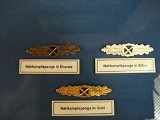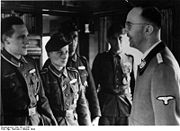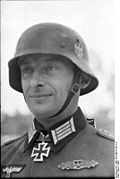
Close Combat Clasp
Encyclopedia
The Close Combat Clasp is a German military award instituted on 25 November 1942 for achievement in hand to hand fighting
in close quarters. The Close Combat Clasp was worn above the upper left uniform pocket. The clasp was die-cast and made of either tombac
or later zinc
, with a slightly curved and hand centerpiece consisting of the national emblem surmounting a crossed bayonet
and hand grenade
.
The award was bestowed in three classes.
On order to receive this distinguished decoration, all battles and their dates had to be officially documented by the battle commander, verified by the general in charge and authenticated by several divisions of the war department. It was possible that more than one close combat battle per day was fought and therefore recorded as a separate entity.
 An exemption was made if the soldier was wounded in battle so badly that his injuries precluded a return to the front. In such a case, the criteria were reduced to 10, 20 and 40 battles. The highest number of battles in combat recorded is listed at 84 by SS-Hauptscharführer Hermann Maringgele
An exemption was made if the soldier was wounded in battle so badly that his injuries precluded a return to the front. In such a case, the criteria were reduced to 10, 20 and 40 battles. The highest number of battles in combat recorded is listed at 84 by SS-Hauptscharführer Hermann Maringgele
The Gold Close Combat Clasp was often regarded in higher esteem than the Knight's Cross of the Iron Cross
by the German infantry. Of the roughly 18 – 20 Million soldiers of the German Wehrmacht and Waffen-SS 36,400 received the Bronze Class, 9,500 the Silver Class and 631 the Gold Class.
 In 1944 a version for the German Air Force was created to note the increasing number of Air Force Personal and Paratroopers taking part in direct combat.
In 1944 a version for the German Air Force was created to note the increasing number of Air Force Personal and Paratroopers taking part in direct combat.
Hand to hand combat
Hand-to-hand combat is a lethal or nonlethal physical confrontation between two or more persons at very short range that does not involve the use of firearms or other distance weapons...
in close quarters. The Close Combat Clasp was worn above the upper left uniform pocket. The clasp was die-cast and made of either tombac
Tombac
Tombac, as spelled in French, or Tombak is a brass alloy with high copper content and 5-20% zinc content. Tin, lead or arsenic may be added for colouration.It is a cheap malleable alloy mainly used for medals, ornament, decoration and some munitions....
or later zinc
Zinc
Zinc , or spelter , is a metallic chemical element; it has the symbol Zn and atomic number 30. It is the first element in group 12 of the periodic table. Zinc is, in some respects, chemically similar to magnesium, because its ion is of similar size and its only common oxidation state is +2...
, with a slightly curved and hand centerpiece consisting of the national emblem surmounting a crossed bayonet
Bayonet
A bayonet is a knife, dagger, sword, or spike-shaped weapon designed to fit in, on, over or underneath the muzzle of a rifle, musket or similar weapon, effectively turning the gun into a spear...
and hand grenade
Hand grenade
A hand grenade is any small bomb that can be thrown by hand. Hand grenades are classified into three categories, explosive grenades, chemical and gas grenades. Explosive grenades are the most commonly used in modern warfare, and are designed to detonate after impact or after a set amount of time...
.
The award was bestowed in three classes.
- For 15 battles of close combat a Bronze Class was awarded.
- For 25 battles of close combat a Silver Class was awarded.
- For 50+ battles of close combat a Gold Class was awarded.
On order to receive this distinguished decoration, all battles and their dates had to be officially documented by the battle commander, verified by the general in charge and authenticated by several divisions of the war department. It was possible that more than one close combat battle per day was fought and therefore recorded as a separate entity.

Hermann Maringgele
Hermann Maringgele was a Untersturmführer in the Waffen-SS during World War II. He was awarded the Knight's Cross of the Iron Cross, which was awarded to recognize extreme battlefield bravery or successful military leadership by Nazi Germany during World War II...
The Gold Close Combat Clasp was often regarded in higher esteem than the Knight's Cross of the Iron Cross
Knight's Cross of the Iron Cross
The Knight's Cross of the Iron Cross was a grade of the 1939 version of the 1813 created Iron Cross . The Knight's Cross of the Iron Cross was the highest award of Germany to recognize extreme battlefield bravery or successful military leadership during World War II...
by the German infantry. Of the roughly 18 – 20 Million soldiers of the German Wehrmacht and Waffen-SS 36,400 received the Bronze Class, 9,500 the Silver Class and 631 the Gold Class.


